
Summer has arrived, and for many of us Minnesotans, gardens are flourishing! Whether you garden yourself or are a frequent farmer’s market shopper, more produce is now locally in season. Let’s talk about what’s in season this month (June) and how to cook with it.
What’s in Season and How Do I Cook with It?
Asparagus
Locally, asparagus is in season from May-June. These green spears are low in calories and packed full of nutrients. One serving of about five spears contains:
- 12% of your daily vitamin C
- 18% of your daily vitamin A
- 57% of your daily vitamin K
- 34% of your daily folate
- Additional smaller values of potassium, phosphorous, and vitamin E
High in antioxidants and many other micronutrients, this is an excellent food to start incorporating into your family’s diet while in season this month. These spears can be enjoyed raw, straight out of the garden. Asparagus can be boiled, pan roasted, grilled, sauteed, and steamed. Be sure to cut or break off the woody bottoms of the asparagus as these can become tough after cooking.
One of our favorite ways to prepare asparagus is to sauté it. It’s easy, it’s healthy, and it’s quick!
Steps to sauté:
- Heat a pan with olive oil (a healthier fat) – about two tablespoons
- Trim woody ends of the bottom of each spear
- Add the spears – depending on your pan size, you may want to cut the asparagus into pieces to better fit
- Sauté until lightly browned and tender - about 3 to 5 minutes.
- Season lightly with salt and pepper or any other seasonings
- Enjoy!
Raspberries
This one probably needs no explanation on how to prepare! Raspberries are easy to enjoy fresh, as a delicious sweet treat. Locally grown raspberries are an excellent choice. Many of the berries at the local farmer’s market or even from a neighbor will not have been treated with any pesticides. While they may not be certified organic, this is still a huge plus.
They are packed with nutrients that include (in one cup):
- 54% of daily vitamin C
- 41% of daily manganese
- 12% of daily vitamin K
- 20-40% of daily fiber
- Smaller amounts of other nutrients like; vitamin E, B vitamins, iron, magnesium, phosphorus, potassium, copper, etc.
Like the asparagus, raspberries also contain antioxidants that have been linked to help prevent certain diseases and cancers.
Strawberries
Again, like raspberries, we recommend enjoying them as is. No preparation, other than washing, is needed. A serving of 1 cup of strawberries contains many nutrients, including:
- 150% of daily vitamin C
- 23% of daily manganese
- Other nutrients include: potassium, folate, iron, copper, magnesium, phosphorus, and vitamins B6, K, and E
Strawberries, loaded with antioxidants, have been linked to numerous health benefits, including improved heart health, blood sugar regulation, and cancer prevention. Next time your kiddos are craving something sweet, pass them the strawberries!
Rhubarb
While you can grab this one right out of the garden for a sour snack, it’s better when made into a tasty dessert. Rhubarb is ideal for a healthier tangy sweet treat packed with nutrients, such as:
- 26% of daily vitamin K1
- 15% of daily Calcium
- Smaller quantities of other nutrients, including vitamin C, potassium, and folate
Here is one of our favorite rhubarb crisp recipes lower in added sugar than others. We love this one as there are very few ingredients, and it is super simple to make.
Knowing What’s in Season
One of the best ways to know what’s in season is to shop locally. Farmer’s markets are a great way to expose yourself to foods that are locally grown and in season. You can also challenge yourself to try something different each week and round out your diet to maximize health benefits.